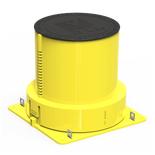Repair of Pipe and Cable Transits Previously Sealed with RTV Silicone Foam
Certain cruise ships built in Europe used plural component RTV silicone foam as the means of sealing pipe and cable penetrations. A popular RTV foam product used in some shipyards was Pensil® 200[1]. As modifications are made to plumbing and electrical systems which were sealed with this material, portions of the foam must be removed, leaving behind small gaps or voids.
Mixing and dispensing plural component RTV silicone foam is inefficient and time-consuming, and also requires that forms be fabricated to retain the material as it expands. As such, these transits are often left unrepaired, or are sealed using materials which are not tested or approved for use in conjunction with RTV silicone foam. In either case, the integrity of the division is compromised, endangering the vessel and those on board.

Recognizing the complications associated with repair of RTV silicone foam, STI Marine has tested and certified use of MFS Marine Firestop Sealant for use in such applications. Lloyd’s Register Type Approval Certificate No. SAS F160268 describes use of MFS Marine Firestop Sealant to repair up to 50% of existing installations of Pensil® 200 or STI Marine Firestop Foam as shown in Figure 1. Further, MFS Marine Firestop Sealant is MED approved, was tested in accordance with the 2010 IMO FTP Code, and fully complies with SOLAS requirements.
Please visit the Type Approvals page to download a copy of the above-referenced Type Approval Certificate.
[1]Pensil® is a registered trademark of Momentive Performance Materials (formerly GE Silicones)


























